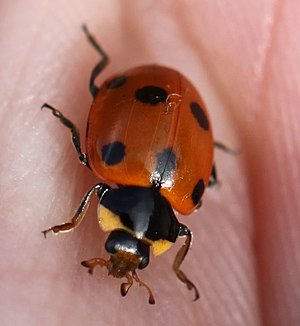Hippodamia undecimnotata
| Hippodamia undecimnotata | ||||||||||||
|---|---|---|---|---|---|---|---|---|---|---|---|---|

Hippodamia undecimnotata |
||||||||||||
| Systematics | ||||||||||||
|
||||||||||||
| Scientific name | ||||||||||||
| Hippodamia undecimnotata | ||||||||||||
| ( DH Schneider , 1792) |
Hippodamia undecimnotata is a beetle fromthe ladybird family (Coccinellidae). The name addition is derived from Latin and means "11 spots".
features
The beetles become 5 to 7 millimeters long. The pronotum and head have a basic black color. The front corners of the pronotum are colored white and connected to each other by a narrow strip along the front edge. The area between the eyes is also colored white. The orange to red colored elytra show a basal black spot on the wing cover seam. Near the front corners, in the rear third near the wing cover seam as well as below this and slightly backwards there is a black spot per cover wing. It also has a black spot in the front third on the outer wing edge and a smaller spot near the rear corner of the wings. These spots are often only hinted at or are completely absent. The legs are black except for the inside of the anterior tibia and the anterior tarsi . The male's third antennae has a corner protruding in the shape of a blunt tooth.
distribution
The species occurs mainly in south-east Europe. The distribution area extends in the west to France and Belgium. In Asia, it occurs in the Middle East and as far as East Asia.
Way of life
The beetle species has different habitats. They can be found on the edges of forests, in clearings, on pine and steppe heaths and on floodplains. There they can often be found on thistles and knapweeds , on representatives of the genus Artemisia , on umbellifers and on junipers . The ladybirds eat mealy plum aphids ( Hyalopterus pruni ) and are therefore considered beneficial insects. In autumn and winter, the beetles often appear en masse under stones.
Taxonomy
The following synonyms can be found in the literature :
- Ceratomegilla undecimnotata ( DHSchneider , 1792)
- Coccinella undecimnotata D. H. Schneider , 1792
- Coccinella novempunctata Geoffroy , 1785
- Coccinella undecimmaculata D. H. Schneider , 1792
- Coccinella cardui Brahm , 1802
- Coccinella maritima Ménétriés , 1832
- Coccinella fulvimana Motschulsky , 1837
- Coccinella saliana Faldermann , 1837
- Adalia undecimnotata
- Semiadalia undecimnotata Schneider
Individual evidence
- ↑ a b c d e Heinz Freude, Karl Wilhelm Harde, Gustav Adolf Lohse (ed.): Die Käfer Mitteleuropas . tape 7 . Clavicornia. Spektrum Akademischer Verlag, Munich 1967, ISBN 3-8274-0681-1 . P. 264
- ↑ a b Arved Lompe: Hippodamia determination table . coleonet.de. Retrieved November 9, 2018.
- ↑ a b c Ceratomegilla (Ceratomegilla) undecimnotata Schneider, DH, 1792 in Fauna Europaea. Retrieved November 9, 2018
- ↑ a b c Klaus Koch : Die Käfer Mitteleuropas Ökologie . 1st edition. tape 2 . Goecke & Evers, Krefeld 1989, ISBN 3-87263-040-7 . P. 247
- ↑ Hippodamia undecimnotata (Schneider, 1792) . www.biolib.cz. Retrieved November 9, 2018.


